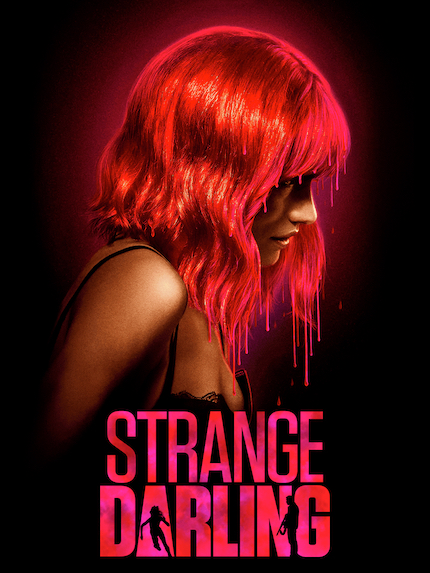STRANGE DARLING Review: Love Hurts, and How
Willa Fitzgerald and Kyle Gallner star in the thriller, directed by JT Mollner and photographed by Giovani Ribisi.

After a brief prologue that promises – both via text and voiceover – a dramatization of the true story of the final killings of the most unique American serial killer of the 21st century, we are treated to a mesmerizing opening titles sequence set to a rendition of "Love Hurts," featuring a woman (Willa Fitzgerald) running through the woods in red scrubs.
The next chapter introduces us to the man chasing her – flannel clad, aviators wearing, moustache rocking Kyle Gallner, whose character is referred to in the credits as The Demon.
Strange Darling is the second feature by the writer/ director JT Mollner, following Outlaws and Angels (2016), a revisionist take on a Western. It stands to reason to suggest that Strange Darling somewhat plays a bit around revising the genre of thriller, and to some extent it does ring true.
The “thriller in six chapters”, as it describes itself, is told in a non-linear way that keeps viewers on their toes and is decidedly devoid of anything that is unfun or boring, including possible explanations and motives. The chapters and bits of information are mixed in a way that best serves the film’s energy and its distinctive voice.
In a recent interview, the director mentioned the idea of giving the film a sort of a dream-like or nightmarish look, and the result does deliver on that end. Shot in Mollner’s trademark 35 mm, it gives out a strong fever dream feel, a trip that is both fun and gone terribly wrong: the subdued faded colors, the ever-present music reigning over the most pivotal plot points, the way the story jumps back and forth slightly manically, and the way red tends to find a way to dominate almost every setting - if it’s not the lightning, then it’s the red scrubs, red walls or red phone, red leather boots or the conceptually significant red panties.
The feeling is emphasized by Giovanni Ribisi’s camera, which manages to keep things intense, not only in the tracking shorts of people chasing each other with guns and running down the street half naked, but also while intimate closeups of two people simply sitting in a car and talking.
The said duet – Fitzgerald and Gallner – are basically an asset in itself, since as much as Strange Darling is an aesthetical adventure, it is also a two-actors show. On the heels of his roles in Haunting in Connecticut, Smile and The Passenger (among others), Gallner switches easily between seemingly gentle, ominous and downright maniacal, in one particularly memorable scene venturing somewhere into the territory of Panos Cosmatos’ Mandy.
Fitzgerald – also not a newcomer in the genre after the Scream TV-series and the promising but sadly underwhelming Beach House (2020) - gets a chance to have even more fun with her material, yet manages to stay grounded even at the trippiest turns of events the story throws at her. Barbara Hershey and Ed Begley Jr. pop in for a bit and effectively chew the scenery.
Despite the looks of a 70s proud exploitation flick, Mollner’s film lives in the present, and manages to stick a few comments about the power dynamics, delusiveness of appearances and taking things at face value, and even the vicissitude of love. Yet, Strange Darling – warranting its title – blessedly doesn’t rely on sense as much as sensibility.
And the refrain of "Love Hurts," which at first just seems to set the tone for a wonderfully self-aware movie that doesn’t take itself too seriously, actually does make a bigger statement here. In a certain way, there is a love story in here after all – the love relationship the authors have with cinema.
Review originally published during Fantastic Fest in September 2023. The film opens August 23, in various Alamo Drafthouse Cinema locations. Visit the official site to see locations and purchase tickets.







